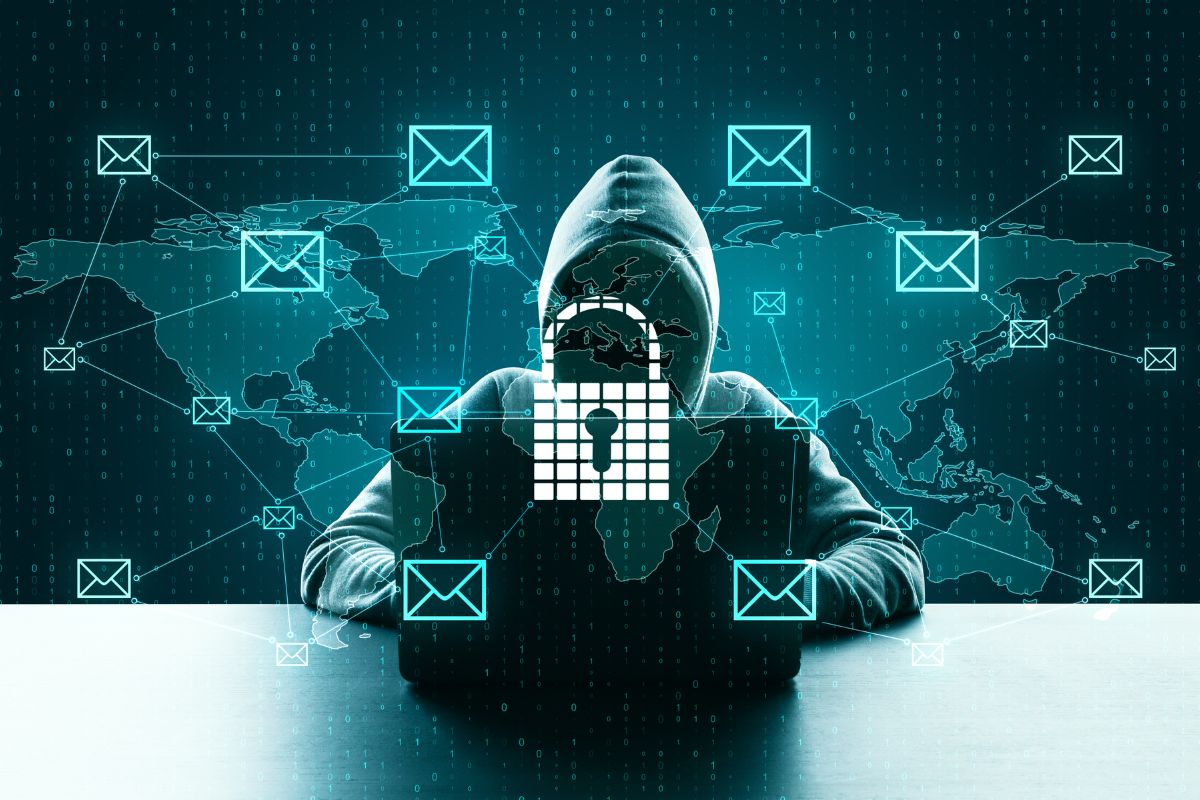Ransomware is malicious software that encrypts files or locks system access, then demands payment (a “ransom”) for a decryption key. Modern attacks often add data exfiltration: attackers steal files and threaten to publish them if the ransom is not paid – a tactic called double extortion. Either way, a successful ransomware infection can cripple your computer or network, causing downtime, data loss, and severe financial or reputational harm.
How Ransomware Spreads
Ransomware typically enters via common attack vectors, exploiting human error or system weaknesses. Key infection paths include:
-
Phishing emails and malicious links: The vast majority of ransomware starts with a spear-phishing email or chat message that lures a user into clicking a link or opening an attachment. Once executed, the malicious payload installs ransomware on the device.
-
Stolen or weak credentials: Attackers often use stolen passwords or brute-force weak logins (for example, open Remote Desktop Protocol (RDP) ports) to gain access. Compromised credentials are a leading cause of breaches; enforcing multi-factor authentication (MFA) is essential to block this vector.
-
Vulnerable software (drive-by attacks): Unpatched operating systems or applications can be exploited when a user visits an infected website or opens a malicious file. Ransomware payloads can be delivered silently via drive-by downloads on compromised sites.
-
Supply-chain or third-party compromises: Attackers may breach a trusted vendor (e.g. a Managed Service Provider) or software update mechanism to distribute ransomware to many victims at once. For example, in 2024 a ransomware attack on a supply-chain vendor disrupted major customers (see Recent Examples).
-
Removable media: Inserting an infected USB drive or portable drive can spread ransomware, especially in insecure environments. Modern ransomware can also self-propagate across networks if it gains a foothold, infecting file shares and other hosts (e.g. WannaCry, Petya).
Guidance from cybersecurity agencies and experts emphasizes vigilance: patch systems promptly, secure remote access, and harden email filters to block malicious attachments or sites.
Types of Ransomware
Ransomware comes in several variants, each with different tactics:
-
Crypto-ransomware: Encrypts user files or entire disks so they become unreadable. Victims must obtain a decryption key from the attacker. (Classic examples include CryptoLocker, and most modern attacks.)
-
Locker ransomware: Locks the user out of the operating system or device (e.g. freezing the screen) without necessarily encrypting files. It demands payment to “unlock” the machine, but can be disruptive even without data loss.
-
Scareware: Displays fake security alerts or antivirus warnings to trick users into “buying” a bogus fix. While often less technically sophisticated, scareware relies on social engineering and fear.
-
Leakware (Doxware): Steals sensitive files (data exfiltration) and threatens to release them publicly unless a ransom is paid. This double-extortion technique greatly increases pressure on victims, since it risks data breach and legal exposure in addition to encryption.
-
Ransomware-as-a-Service (RaaS): Not a type of malware per se, but a business model: cybercriminals sell or lease ready-made ransomware kits to affiliates. This lowers the skill barrier and has fueled a proliferation of new groups. (RaaS platforms allow even amateurs to launch attacks.)
-
Fileless ransomware: Operates in memory and uses legitimate system tools (like PowerShell) to encrypt files without leaving traditional malware files on disk. Because it uses normal processes, it can evade many antivirus solutions.
Each variant requires somewhat different defenses. For instance, crypto- and leakware attacks demand secure backups and encryption controls, while locker ransomware can be mitigated by enforcing logon protections and account lockdown. The emergence of RaaS and double-extortion means ongoing vigilance is vital. (Notably, 2024 saw new RaaS groups like RansomHub and Qilin emerge, using advanced tactics.)
Protection for Personal Users
Individuals can take several practical steps to greatly reduce ransomware risk:
-
Keep systems and software up-to-date: Enable automatic updates for your operating system, web browser, and all applications. Promptly install security patches – many ransomware attacks exploit known vulnerabilities.
-
Use reputable security software: Install and maintain anti-malware/antivirus software (with real-time protection and email/web scanning). Some consumer security suites include specific anti-ransomware features.
-
Practice safe browsing and email hygiene: Never open email attachments or click links unless you are certain of the sender’s legitimacy. Be wary of unsolicited messages urging urgent action. Hover over links to verify URLs, and avoid downloading software or media from untrusted sites.
-
Use strong, unique passwords and MFA: Secure your accounts with long, random passwords. Where possible, enable multi-factor authentication (MFA) on email, cloud storage, and any remote access services. This way, even if passwords are stolen, attackers cannot easily log in.
-
Limit user privileges: Operate with a standard (non-administrative) account for daily tasks. Ransomware running under a non-admin user often cannot reach system files or spread as widely. Only use an admin account when installing software or making system changes.
-
Regularly back up your data: Maintain current copies of important files on a separate device or cloud service. Follow the 3-2-1 rule: keep at least three copies of data on two different media, with one copy off-site or offline. Offline, encrypted backups are ideal. Do not rely solely on live-synced cloud backups, because ransomware can encrypt files and those changes may propagate to the cloud. Periodically test restoring from your backups to ensure they work.
Implementing these measures as an individual greatly lowers your chance of infection. Even if a device is hit, having backups and updated defenses means you can restore your files without yielding to the attacker.
Protection for Organizations
Businesses and institutions must layer technical controls with policies and training:
-
Patch and Update Policy: Establish strict patch management. Automate or enforce timely installation of all security updates on servers, workstations, and network devices. Vulnerability scans and asset inventories help ensure no system is forgotten.
-
Strong Access Controls: Enforce the principle of least privilege. Employees should have only the rights they need. Disable unused accounts and services. Require MFA on all accounts with network or email access (especially administrator, VPN, and email accounts). This blocks attackers from moving laterally even if a password is phished.
-
Network Segmentation: Divide the internal network into zones (e.g. by department or trust level) so that a breach in one segment cannot freely spread everywhere. Critical servers should be isolated behind firewalls and separate VLANs. Restrict RDP/SSH access to known IPs and consider VPN/MFA for all remote logins.
-
Endpoint Protection and Monitoring: Deploy enterprise-grade anti-malware and EDR (Endpoint Detection & Response) tools on all endpoints. These can block known ransomware and detect suspicious behavior (like rapid file encryption). Use network intrusion detection systems (IDS/IPS) and keep robust logging (Security Information and Event Management – SIEM) to spot anomalies.
-
Email and Web Filtering: Use advanced email gateways or cloud filters that scan for malicious attachments and links. Some products employ AI to detect phishing. Block or sandbox risky file types (e.g. macros, executables) from email. Similarly, web gateways should block known malicious domains.
-
Security Policies: Document and enforce security policies covering password rules, device usage, and software installation. For example, prohibit unauthorized software and implement application whitelisting where feasible. Maintain an up-to-date incident response plan so staff know exactly what to do if an infection is suspected.
-
Third-Party Risk Management: Require suppliers and partners to follow strong security (including MFA and secure update processes). Monitor for software supply-chain threats. Limit trusted network connections to outside entities to only those absolutely needed.
-
Regular Backups: Like personal users, organizations must back up data and system images frequently. Backups should be offline or air-gapped so attackers cannot easily reach them. Maintain “golden images” or virtual-machine snapshots of key servers so systems can be quickly rebuilt. Test recovery procedures regularly to ensure continuity.
-
Employee Training: Since many infections start with human error, conduct ongoing security awareness. Train staff to recognize phishing and social engineering (even by phone or SMS). Perform simulated phishing campaigns and share lessons learned. Encourage a culture of “stop and verify” – if an email looks odd or urgent in a way that doesn’t fit normal policy, employees should flag it immediately.
By combining technical defenses with well-enforced policies and trained personnel, organizations create a robust defense-in-depth that significantly reduces ransomware risk.
Backup and Recovery Best Practices
A cornerstone of ransomware defense is resilient backups:
-
3-2-1 Backup Rule: Keep at least three copies of critical data, on two different media, with one copy off-site or offline. For example, maintain files on servers or NAS, plus regular images on an external drive or tape, and a remote cloud backup.
-
Offline/Immutable Storage: Use backups that attackers cannot easily access. This means physical disconnection (air-gapped media) or immutable cloud snapshots. CISA/FBI guidance explicitly advises offline, encrypted backups, noting that “most ransomware actors attempt to find and subsequently delete or encrypt accessible backups”.
-
Cloud Backups Caution: Simply syncing to cloud storage is not enough. If your files are encrypted by ransomware, the corrupted versions will sync and overwrite the good cloud copy. To avoid this, configure cloud services to keep versioned backups or maintain a separate backup that isn’t auto-synced.
-
Regular Testing: Periodically perform restore drills. Verify that backups are complete and uncorrupted, and that recovery steps work. A backup strategy is useless unless it’s tested – attackers may ransom data months before triggering encryption.
-
System Images and Templates: Maintain updated “golden images” of servers and desktops (with a clean OS and software configuration). This allows rapid rebuilding of systems without having to reinstall and patch from scratch. Store these images securely (and offline if possible).
-
Secure Backup Infrastructure: Protect backup servers and software just like any system: keep them patched, require strong authentication, and segregate them from the general network. Disable any SMBv1 or other legacy protocols.
Following these backup best practices ensures that, if a ransomware infection occurs, you can restore operations without paying. For example, SentinelOne advises victims to restore from backups as the preferred action, and to treat paying ransom as a last resort because it does not guarantee recovery.
Employee Training and Awareness
Human vigilance is the final and critical layer of defense. Even the best defenses can be bypassed by clever social engineering, so ongoing education is vital:
-
Phishing Training: Teach employees to recognize phishing red flags (unusual sender, unexpected urgency, odd language). Use real-world examples and share current ransomware email tactics. Simulate phishing tests and discuss results in a non-punitive way.
-
Reporting Procedures: Make it easy for staff to report suspicious emails or incidents. Encourage an “abnormal email hotline” or automated reporting button. Quick reporting can contain an attack before it spreads.
-
Password Hygiene: Emphasize the use of passphrases or long unique passwords. Recommend password managers. Enforce policies against password reuse. Remind staff that even one reused password can compromise multiple systems.
-
Role-Specific Training: Provide extra training for high-risk roles (e.g. finance, HR) who may be targeted with more sophisticated phishing (like fake invoices). Ensure IT and security personnel are up-to-date on the latest ransomware threats and defensive tools.
-
Cybersecurity Culture: Promote a mindset of “trust, but verify.” Employees should feel empowered to question unusual requests (even from a boss) and to verify links or invoices through a second channel.
Studies show that organizations with strong security cultures and regular training suffer far fewer breaches. In fact, a recent analysis emphasizes that “even the best security tools can’t fix poor cybersecurity habits,” noting that most ransomware starts with user error. Training is therefore one of the most cost-effective defenses.
Incident Response and Recovery Steps
No prevention is perfect. Every organization should be prepared with a concrete response plan. If a ransomware attack is discovered, key steps include:
-
Isolate the Infection: Immediately disconnect affected machines from the network (unplug Ethernet, disable Wi-Fi) to prevent lateral spread. Do not turn off the device abruptly if possible – some forensic detail can be learned while it’s still on (but do prevent further damage).
-
Assess and Identify: Determine which systems and files are encrypted or stolen. Identify the ransomware strain if possible (often the ransom note or file extension gives clues). This helps find known decryption tools or remediation steps. Check whether backups are intact and unencrypted.
-
Notify Authorities: Report the incident to law enforcement (e.g. FBI in the U.S.) and relevant regulatory bodies. This is important both legally and for gathering intelligence. Agencies increasingly support victims (some have decryption keys for certain ransomware families). Engaging law enforcement may also advise against paying the attacker.
-
Engage Cybersecurity Experts: If you have an internal SOC/IR team, activate them. Otherwise, engage a trusted incident response firm. Experts can analyze the breach, contain it, and assist with forensic evidence collection. They can also guide recovery and communication.
-
Restore from Backup: Assuming backups are available, wipe infected systems and restore them from known-clean backups. Change all passwords and credentials used on infected machines before bringing them back online.
-
Systems Rebuild (if needed): In some cases (or if backups are not recent), it may be safer to rebuild systems from scratch rather than decrypt. CISA recommends using “golden images” to quickly redeploy clean OS configurations. Install all patches and updates before reconnecting to the network.
-
Deciding on Payment: As a last resort, an organization might consider paying. However, law enforcement and experts strongly advise against paying ransom, because it encourages attackers and may not yield data. If someone does pay, it should be under expert guidance and with full awareness that recovery is not guaranteed.
-
Communication: Have a communication plan ready. Notify affected stakeholders (customers, employees) as required by law or good practice. Transparency can mitigate reputational damage. Coordinate any public statements carefully with legal and PR teams.
After recovery, conduct a post-incident review. Analyze how the breach occurred and plug any holes (e.g. update firewalls, enforce new email checks). Learn from the event to strengthen future defenses. This “lessons learned” process is essential to improve cyber resilience.
Recent Ransomware Trends and Examples
Ransomware remains a fast-evolving threat. Recent incidents highlight its scale and targets:
-
Skyrocketing Ransoms: In 2024 the total paid ransoms hit record highs. For example, one Fortune 50 company reportedly paid $75 million to the “Dark Angels” group – the largest confirmed ransom ever. The median ransom demand rose into the millions of dollars.
-
Healthcare Under Siege: According to IBM, 67% of healthcare organizations were hit by ransomware in early 2024, with average demands over $5.2 million. Healthcare is especially vulnerable because downtime can be life-threatening.
-
Supply-Chain Attacks: Ransomware is increasingly hitting service providers and vendors. Notably, a November 2024 hack of Blue Yonder (a workforce-management vendor) disrupted Starbucks’ US operations, forcing baristas to use paper schedules. Such supply-chain breaches show that any connected business can be at risk.
-
New Ransomware Groups: Despite law enforcement crackdowns, new gangs keep emerging. For example, RansomHub was a Ransomware-as-a-Service group active in 2024 (with ties to ALPHV/LockBit affiliates). Its rapid rise and eventual takedown illustrate the “whack-a-mole” nature of this threat. Similarly, a new Rust-based RaaS called Qilin appeared in 2025, using double-extortion on tailored targets.
-
Credential Theft Dominance: Industry reports (e.g. Verizon, BitSight) show that stolen or reused credentials account for a majority of intrusions. In fact, recent data indicates organizations with MFA suffer far fewer breaches. This underscores why strong authentication is non-negotiable.
Key takeaway: Ransomware continues to evolve (often leveraging AI tools), but the core defenses remain the same layers: up-to-date systems, strong access controls, reliable backups, and a security-aware workforce. By diligently applying the strategies above, both individuals and organizations can significantly reduce the risk of becoming a ransomware victim.









